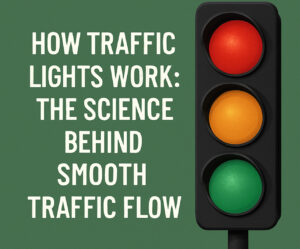Urban congestion has become one of the biggest challenges for modern cities. As populations grow and more vehicles crowd the roads, outdated infrastructure and manual systems can no longer keep up. This is where traffic control systems, traffic control signs, and traffic control signs for sale come into play—not just as traditional tools, but as part of a smarter, tech-driven future. Adaptive Traffic Control Systems (ATCS) are transforming how cities manage mobility, using real-time data to make roads safer, more efficient, and better for everyone. Know more..
What Are Adaptive Traffic Control Systems?
Adaptive Traffic Control Systems (ATCS) are intelligent systems that adjust traffic signals in real time based on current conditions. Unlike fixed-timing signals, ATCS use sensors, cameras, and algorithms to optimize traffic flow. They can reduce congestion, cut down travel time, and improve fuel efficiency by responding instantly to traffic volume, incidents, or unusual patterns.
While traffic control signs have long played a crucial role in managing road safety and order, pairing them with adaptive technology offers a leap forward. Imagine signs for traffic control that work in sync with dynamic traffic lights or even alert autonomous vehicles in the future.
The Evolution of Traffic Management
Traditional traffic systems rely heavily on pre-set cycles and static traffic control signs. These systems are limited in their ability to respond to unexpected traffic surges, construction zones, or emergencies. With urban sprawl increasing, cities are finding that old systems lead to inefficiency, frustration, and even accidents.
Enter ATCS. These systems monitor live traffic conditions and adapt light patterns accordingly. When integrated with signs for traffic control, they offer a smart, scalable solution for urban mobility. As cities move toward smart infrastructure, traffic control signs for sale are evolving into network-connected assets that serve real-time functions.
How ATCS Work in Real-Time
ATCS work by collecting data through road-embedded sensors, traffic cameras, and sometimes even GPS data from connected vehicles. This data is processed through algorithms that analyze traffic flow and make split-second decisions.
For example, if one direction experiences a spike in vehicles due to an accident or event, the system can immediately extend green lights in that direction. Meanwhile, traffic control signs provide visual cues and support for drivers, ensuring seamless navigation.
Benefits of Adaptive Systems
The advantages of Adaptive Traffic Control Systems are numerous and well-documented:
- Reduced Congestion: Real-time traffic flow adjustments keep vehicles moving.
- Lower Emissions: Smoother traffic means less idling and reduced CO2 output.
- Improved Emergency Response: Dynamic routing and signal priority can help emergency vehicles move faster.
- Safety Enhancement: When paired with signs for traffic control, adaptive systems reduce intersection crashes and improve pedestrian safety.
- Cost Efficiency: Though initial investment is higher, reduced maintenance and increased flow lower long-term costs.
In short, integrating traffic control signs into adaptive systems results in smarter cities.
Where Traditional Signs Still Matter
Despite advances in tech, traditional traffic control signs for sale are far from obsolete. They still form the foundation of road communication—telling drivers where to stop, yield, merge, or detour. In fact, signs for traffic control are critical during power outages or system failures, when digital elements may go offline.
Physical traffic control signs also provide consistency. Drivers understand and respond to them universally, which is essential when new technology is still rolling out unevenly across regions.
Integration Is Key
The future isn’t about replacing traffic control signs—it’s about enhancing them. Smart cities are beginning to integrate signs with ATCS to provide layered, real-time information. Some signs now feature LED displays that can change messages based on current road conditions.
Think of construction zones with traffic control signs for sale that include digital alerts for real-time updates, or detour notices synced with mobile GPS apps. This hybrid approach makes roads more intuitive and responsive.
Smart Infrastructure and Data Sharing
Adaptive systems thrive on data. As vehicle-to-infrastructure (V2I) communication becomes more common, traffic control signs can share and receive data from cars, public transit, and even pedestrians with smartphones.
This creates a traffic ecosystem where information flows continuously. For example, if a traffic camera spots a stalled vehicle, it can trigger changes in signal timing and display warnings on signs for traffic control down the road, giving drivers time to reroute.
Traffic control signs for sale are now being designed with connectivity in mind. New models come equipped with sensors, solar panels, and communication modules that feed into broader traffic systems.
Global Cities Leading the Way
Cities like Los Angeles, Singapore, and London are already embracing ATCS with measurable success. Los Angeles, for instance, uses one of the world’s largest adaptive traffic control networks, covering thousands of intersections. The system has reduced travel times by up to 12%.
In Singapore, adaptive systems are integrated with public transportation data to manage both vehicles and buses in a synchronized way. Traffic control signs with dynamic messaging update in real time to reflect traffic changes and guide commuters effectively.
The Role of AI and Machine Learning
Artificial Intelligence is increasingly embedded in ATCS. Machine learning allows systems to predict traffic trends and optimize flow proactively. Over time, these systems learn from patterns—morning rush hours, weekend lulls, or event-driven surges—and adjust accordingly.
This intelligence complements traffic control signs by ensuring that physical signage remains aligned with what drivers experience in real time. A sudden change in traffic doesn’t confuse drivers when signs for traffic control and signal timing are in sync.
Opportunities for Businesses and Municipalities
For municipalities and private road contractors, investing in traffic control signs for sale that are compatible with ATCS can be a smart move. These signs don’t just enhance safety; they future-proof infrastructure projects and ensure compliance with evolving urban standards.
Businesses in the traffic equipment sector should consider offering bundles that include both adaptive components and high-quality traffic control signs. This provides clients with a turnkey solution to modern road challenges.
Future-Proofing Urban Mobility
As driverless cars, smart public transportation, and connected infrastructure become the norm, ATCS will play a pivotal role. Traditional signs for traffic control will evolve but remain essential to road safety and navigation.
Expect to see traffic control signs embedded with sensors, interactive displays, and even voice alerts. The merging of physical and digital traffic management will define the next generation of urban planning.
Final Thoughts
Adaptive Traffic Control Systems represent more than just a tech upgrade—they signal a shift toward intelligent, responsive urban mobility. When thoughtfully integrated with traffic control signs, signs for traffic control, and modern traffic control signs for sale, they can revolutionize how we navigate our cities.
This is the future of mobility: one where technology and tradition work together to make roads safer, faster, and more efficient. Whether you’re a city planner, traffic engineer, or infrastructure investor, the time to adapt is now.





